Shopping Cart
- Remove All
 Your shopping cart is currently empty
Your shopping cart is currently empty

Okanin shows significant activities on both linoleic acid peroxidation inhibition and DPPH radical scavenging effect.

| Pack Size | Price | Availability | Quantity |
|---|---|---|---|
| 1 mg | $80 | In Stock | |
| 5 mg | $272 | In Stock | |
| 10 mg | $328 | In Stock | |
| 25 mg | $553 | In Stock | |
| 50 mg | $789 | In Stock | |
| 100 mg | $1,070 | In Stock | |
| 1 mL x 10 mM (in DMSO) | $229 | In Stock |
| Description | Okanin shows significant activities on both linoleic acid peroxidation inhibition and DPPH radical scavenging effect. |
| In vitro | Activity-guided fractionation of the EtOH extract of flowers of Bidens bipinnata L. have been furnished five flavonoids, sulfuretin(1), butein(2), 7,8,3?2,4?2-tetrahydroxyflavanone(3), maritimetin(4) and Okanin(5). All of the compounds showed significant activities on both linoleic acid peroxidation inhibition and DPPH radical scavenging effect. The evaluation for protective effect of isolated compounds against tacrine-induced cytotoxicity in human liver-derived Hep G2 cells was conducted. Compounds 1, 3, 4 and 5 showed significant protective effects with the EC50 values of 36.1±0.9, 23.3±0.7, 41.0±1.0 and 29.8±1.1 μM, respectively[1] |
| Molecular Weight | 288.25 |
| Formula | C15H12O6 |
| Cas No. | 484-76-4 |
| Smiles | Oc1ccc(\C=C\C(=O)c2ccc(O)c(O)c2O)cc1O |
| Relative Density. | 1.584 g/cm3 (Predicted) |
| Storage | Powder: -20°C for 3 years | In solvent: -80°C for 1 year | Shipping with blue ice. | ||||||||||||||||||||||||||||||
| Solubility Information | DMSO: 27.5 mg/mL (95.4 mM), Sonication is recommended. | ||||||||||||||||||||||||||||||
Solution Preparation Table | |||||||||||||||||||||||||||||||
DMSO
| |||||||||||||||||||||||||||||||

Copyright © 2015-2025 TargetMol Chemicals Inc. All Rights Reserved.